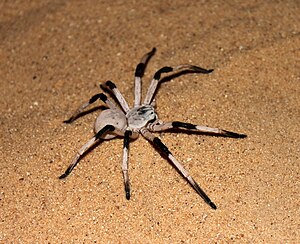Cerbalus aravaensis
| Cerbalus aravaensis | ||||||||||||
|---|---|---|---|---|---|---|---|---|---|---|---|---|

Cerbalus aravaensis |
||||||||||||
| Systematics | ||||||||||||
|
||||||||||||
| Scientific name | ||||||||||||
| Cerbalus aravaensis | ||||||||||||
| Levy , 2007 |
Cerbalus aravaensis is a species of spider from the family of giant crab spiders (Sparassidae), which was only discovered in 2003 in the sand dunes of the Arava in southern Israel and Jordan . The spider is around 14 cm tall including legs (wingspan), making it the largest giant crab spider in the Middle East .
features
The females grow up to around 3 cm long, the males remain slightly smaller. The carapace is sand-colored, light gray to yellowish, and densely covered with fine bristles. A dark brown band extends dorsally across the middle of the carapace and ends in front at the tips of the chelicerae . The abdomen is uniformly cream-colored and has no special markings. The strikingly strong legs can be used for digging in the sand. They have the same basic color as the carapace, but are black at the joints and tips. The front middle eyes are the largest, the back the smallest. The clypeus , between the front pair of eyes and the edge of the carapace, is very narrow.
Cerbalus aravaensis is similar to the species Cerbalus psammodes , which is also native to Israel, in the Negev desert around Elusa . However, the males differ from this species by a short, pointed process with thread-like thickenings on the underside of the two pedipalps . A similar extension is found on the rails of the Pedipalps. The females differ from those of the species Cerbalus psammodes by the internal shape of the spermatheks .
distribution
The Arava Depression in the southern border area of Israel and Jordan belongs geologically to the Great Rift Valley . It forms an enclave that is bordered by mountains as well as the Dead Sea and the Red Sea . Due to the isolation, Cerbalus aravaensis was able to develop independently in this valley, there were crossing barriers with the closely related species Cerbalus negebensis and Cerbalus psammodes . According to current knowledge, the occurrence of the species is limited to the shifting dunes and the more stable sand concretions on the edge of the salt marshes, the spider is endemic in the Arava Depression .
Way of life
Cerbalus aravaensis lives in a hot, arid climate . Nevertheless, the spiders are mainly active in summer. During the hottest months of the year in their area of distribution, in July and August, it is the males in particular that migrate. The spiders are nocturnal and live in underground caves during the day, which are closed with a kind of trap door made of sand glued together with spider silk. This operculum not only provides good camouflage for the entrance, but above all protection against sandstorms.
Danger
The Samar sand dunes in the south of the Arava, where most of the population of Cerbalus aravaensis reside , are the only ones left in this area. They used to cover an area of around 7 square kilometers, but have now shrunk to 2.6 square kilometers. The disappearance of the sand dunes, which are threatened by the expansion of agricultural areas and the resumption of sand mining, would result in the species becoming extinct .
Taxonomy
The species was from the Israeli biologists and arachnologists Gershom Levy in 2007 first described . The specific epithet aravaensis refers to the spider's habitat, the Arava Depression. It is often misrepresented as aravensis or arvensis in popular science articles .
literature
- Gershom Levy: Calommata (Atypidae) and new spider species (Araneae) from Israel. Zootaxa, 1551, pp. 1–30, 2007, pp. 17–18 (first description)
Individual evidence
- ↑ Gershom Levy: Calommata (Atypidae) and new spider species (Araneae) from Israel. Zootaxa, 1551, 2007, Introduction, p. 2 ( Online (PDF; 22 kB), English)
- ↑ a b University of Haifa: New Spider Species Is Largest of Its Type in Middle East ScienceDaily, January 11, 2010 (accessed March 8, 2011)
- ↑ a b Gershom Levy: Calommata (Atypidae) and new spider species (Araneae) from Israel. Zootaxa, 1551, pp. 1-30, 2007, p. 17
- ↑ Arava Special Agriculture ( Memento of the original from December 27, 2010 in the Internet Archive ) Info: The archive link was inserted automatically and has not yet been checked. Please check the original and archive link according to the instructions and then remove this notice. Go Israel, Geography and Nature (English)
- ↑ Yael Lubin, Efrat Gavish-Regev: In Memoriam Gershom Levy (1937 to 2009). In: Israel Journal of Entomology Vol. 38, 2008, p. 138. ( Online ; PDF; 406 kB)